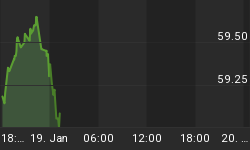SIGNS OF THE TIMES:
This Year:
The blaming of a $7 billion hit to SoGen on one trader seems to be taking our old observation that "The bigger the trading loss-the more unauthorized the trade" to hitherto unimaginable levels.
The full story is not out yet. However, considering the enormity of widespread losses, dire exclamations would be natural, but have been subdued, or perhaps we missed some. Or maybe, the lack is indicating that the worst will be discovered over the next hill.
Last Year:
"Credit Woes Chip at Banks"
"Even as the big banks crank out double-digit earnings gains, weakening in credit quality is showing up."
- Wall Street Journal, January 18, 2007
"Conservative Investors Line Up For Junk Bonds"
"The junk-bond market is undergoing a sort of gentrification, appealing to more conservative investors, who like many in the current low-yield environment, are starved for higher returns."
- Wall Street Journal, January 20, 2007
The old "reaching for the extra 1/8th in yield" is always and inevitably a killer. Well, the best that can be said for the exposure is that they were onside for a a few months as the yield and spreads went the consensus way until May when the yield had declined from 9.75% to 9.25%. With this the spread narrowed to a record 4.18%.
Now the yield is 14.32%, which represents a plunge from 106 to 71, or 35 points. Not nice, and there is a lot further to go as eventually many bonds will be quoted in parts per million (ppm), rather than as percentage of par. And the spread has now reached 10 percentage points over treasuries.
Stock Markets: We have had the month of January as a possible low for the initial phase of forced liquidation of suddenly insupportable positionsin the stock markets. This was global and dislocated most sectors.
Using the Nasdaq, the "crash" ran for the typical 55 trading days to Wednesday, January 22. With this accomplished, the rebound could run into March and retrace some 40% to 50% of the loss. It is worth emphasizing that the break followed mounting problems in the credit markets, which change is first in the order in ending a boom and starting a cyclical contraction. The irony is that the next step on the way is the break in the stock market, which is inevitablyfollowed by the economy rolling over.
Earnings usually turn with commodities, and those who "study" the economy to determine the course of the stock market are working with a self-imposedand costly handicap.
While there could be unsettling news items, the general market could recoverto a tradable high in the next 6 to 8 weeks.
Gold Sector: Technically gold's nominal price has been acting well. The correction down to the 20-day moving average at around the third week in January, was expected to be followed by continuation to beyond 905. The correction low was 868 on January 22 and the rally made it to 942yesterday.
Needless to say, but gold has been gathering more widespread popularity - even wistfulness amongst those following orthodox theories about portfolio management. So,where do we go from here?
One aspect is that it is yet another rotation into the latest fashionable game. This may be so, but our view has been is that some of the move is due to increased investment demand with the onset of the credit contraction. This shows up in the real price of gold, which reached a cyclical low in May at 143. This, of course, is when the credit markets reversed and our gold/commoditiesindex has rallied to 230 this week.
However, in the past week the senior gold indexes have not kept pace withthe bullion move, suggesting that the sector could have a brief rest.
* * * * *
Much is being said about Bernanke's "Helicopter Money", and some have concluded that the Fed, in its desperation to prove that interventionist theories always work, will depreciate the dollar to zero. Of course, great financial distortions can only occur when intellectuals focus upon the markets and the blunders canbe monumental.
For example, during the notorious German inflation of the early 1920s leading economists found compelling reasons to keep it going. That really was a printing press inflation and, given the technology of the day, it could have been called "Autogyro Money". No matter what it is called it destroyed Germany's economy and political culture. But on the way, leading economists found reasons to keep the rip-offgoing, that in today's light seem nonsensical.
"In proportion to the need, less money circulates in Germanynow than before the war."
- Prof. Julius Wolfe, Summer 1922
"However enormous may be the apparent rise in the circulationin 1922, actually the real figures show a decline."
- Prof. Karl Eister, 1923
A couple of generations of gold bugs have been claiming that the Fed would ultimately accomplish such an inflation. Our point has always been that in the early 1920s Germany had no bond market to destroy, and that the U S bond market and its "Vigilantes" would prevent the actual printing of paper currency. And now a credit contraction is underway that will likely forcefully prevent the Fed from further massive depreciation by any means.
Link to February 1, 2008 'Bob and Phil Show' on Howestreet.com: http://www.howestreet.com/index.php?pl=/goldradio/index.php/mediaplayer/766
















